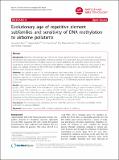| dc.contributor.author | Byun, Hyang-Min | en_US |
| dc.contributor.author | Motta, Valeria | en_US |
| dc.contributor.author | Panni, Tommaso | en_US |
| dc.contributor.author | Bertazzi, Pier Alberto | en_US |
| dc.contributor.author | Apostoli, Pietro | en_US |
| dc.contributor.author | Hou, Lifang | en_US |
| dc.contributor.author | Baccarelli, Andrea A | en_US |
| dc.date.accessioned | 2014-02-18T18:11:00Z | |
| dc.date.issued | 2013 | en_US |
| dc.identifier.citation | Byun, Hyang-Min, Valeria Motta, Tommaso Panni, Pier Alberto Bertazzi, Pietro Apostoli, Lifang Hou, and Andrea A Baccarelli. 2013. “Evolutionary age of repetitive element subfamilies and sensitivity of DNA methylation to airborne pollutants.” Particle and Fibre Toxicology 10 (1): 28. doi:10.1186/1743-8977-10-28. http://dx.doi.org/10.1186/1743-8977-10-28. | en |
| dc.identifier.issn | 1743-8977 | en |
| dc.identifier.uri | http://nrs.harvard.edu/urn-3:HUL.InstRepos:11717537 | |
| dc.description.abstract | Background: Repetitive elements take up >40% of the human genome and can change distribution through transposition, thus generating subfamilies. Repetitive element DNA methylation has associated with several diseases and environmental exposures, including exposure to airborne pollutants. No systematic analysis has yet been conducted to examine the effects of exposures across different repetitive element subfamilies. The purpose of the study is to evaluate sensitivity of DNA methylation in differentially‒evolved LINE, Alu, and HERV subfamilies to different types of airborne pollutants. Methods: We sampled a total of 120 male participants from three studies (20 high-, 20 low-exposure in each study) of steel workers exposed to metal-rich particulate matter (measured as PM10) (Study 1); gas-station attendants exposed to air benzene (Study 2); and truck drivers exposed to traffic-derived elemental carbon (Study 3). We measured methylation by bisulfite-PCR-pyrosequencing in 10 differentially‒evolved repetitive element subfamilies. Results: High-exposure groups exhibited subfamily-specific methylation differences compared to low-exposure groups: L1PA2 showed lower DNA methylation in steel workers (P=0.04) and gas station attendants (P=0.03); L1Ta showed lower DNA methylation in steel workers (P=0.02); AluYb8 showed higher DNA methylation in truck drivers (P=0.05). Within each study, dose–response analyses showed subfamily-specific correlations of methylation with exposure levels. Interaction models showed that the effects of the exposures on DNA methylation were dependent on the subfamily evolutionary age, with stronger effects on older LINEs from PM10 (p‒interaction=0.003) and benzene (p‒interaction=0.04), and on younger Alus from PM10 (p-interaction=0.02). Conclusions: The evolutionary age of repetitive element subfamilies determines differential susceptibility of DNA methylation to airborne pollutants. | en |
| dc.language.iso | en_US | en |
| dc.publisher | BioMed Central | en |
| dc.relation.isversionof | doi:10.1186/1743-8977-10-28 | en |
| dc.relation.hasversion | http://www.ncbi.nlm.nih.gov/pmc/articles/PMC3717285/pdf/ | en |
| dash.license | LAA | en_US |
| dc.subject | Environment | en |
| dc.subject | Exposures | en |
| dc.subject | DNA methylation | en |
| dc.subject | Repetitive elements | en |
| dc.subject | Subfamily | en |
| dc.title | Evolutionary age of repetitive element subfamilies and sensitivity of DNA methylation to airborne pollutants | en |
| dc.type | Journal Article | en_US |
| dc.description.version | Version of Record | en |
| dc.relation.journal | Particle and Fibre Toxicology | en |
| dash.depositing.author | Byun, Hyang-Min | en_US |
| dc.date.available | 2014-02-18T18:11:00Z | |
| dc.identifier.doi | 10.1186/1743-8977-10-28 | * |
| dash.contributor.affiliated | Byun, Hyang-Min | |


